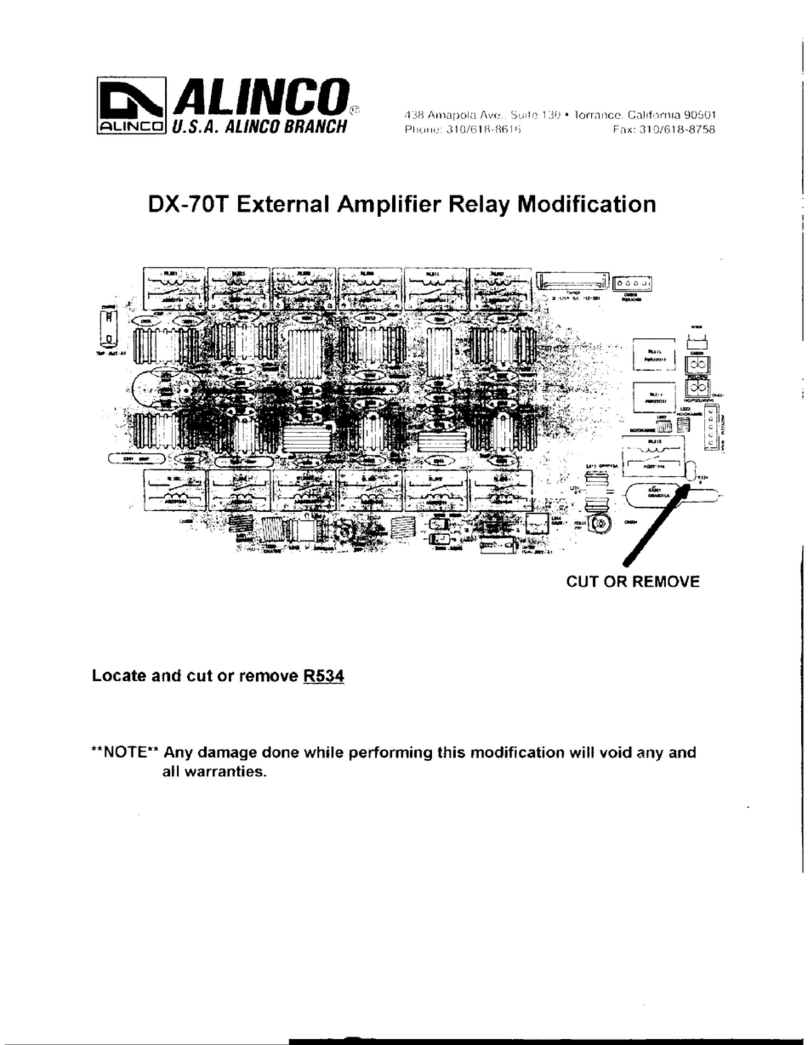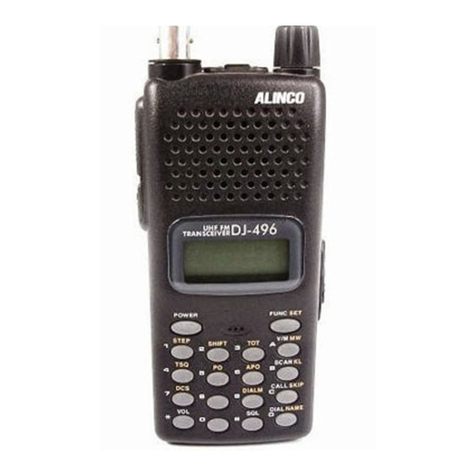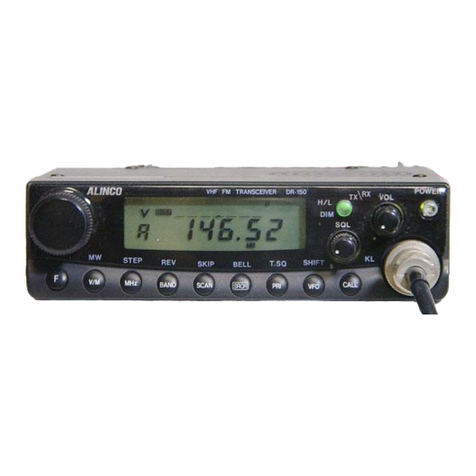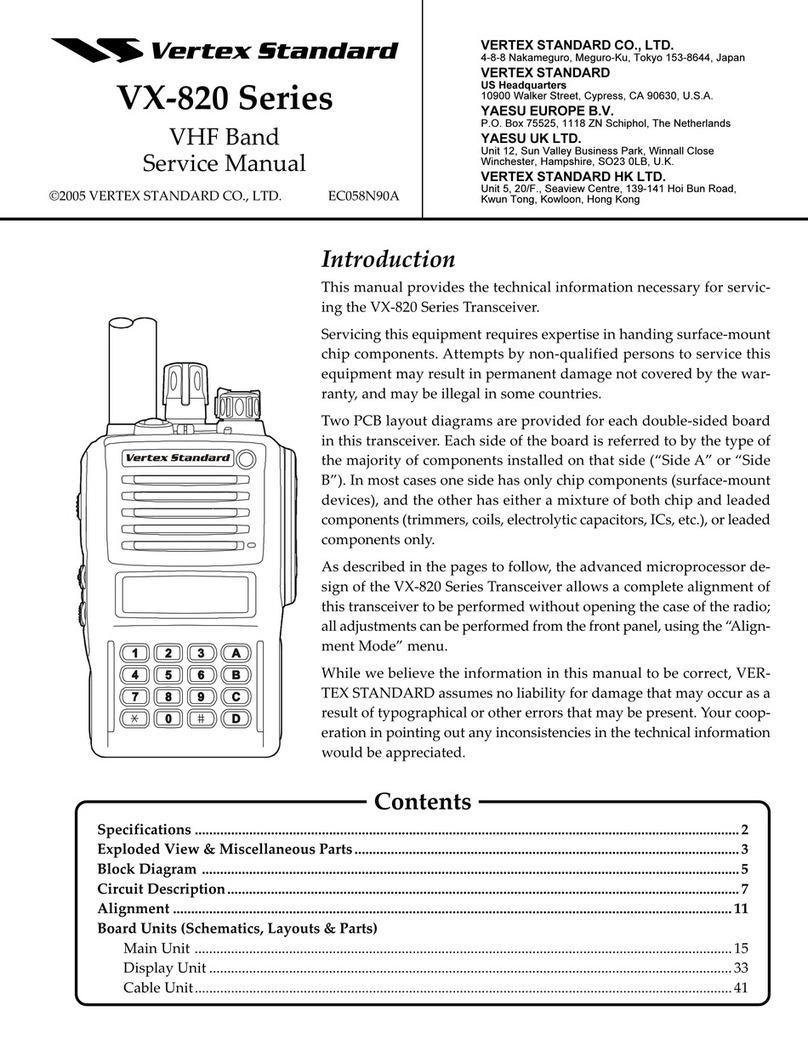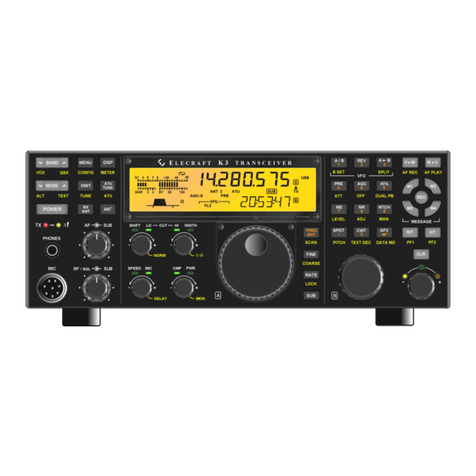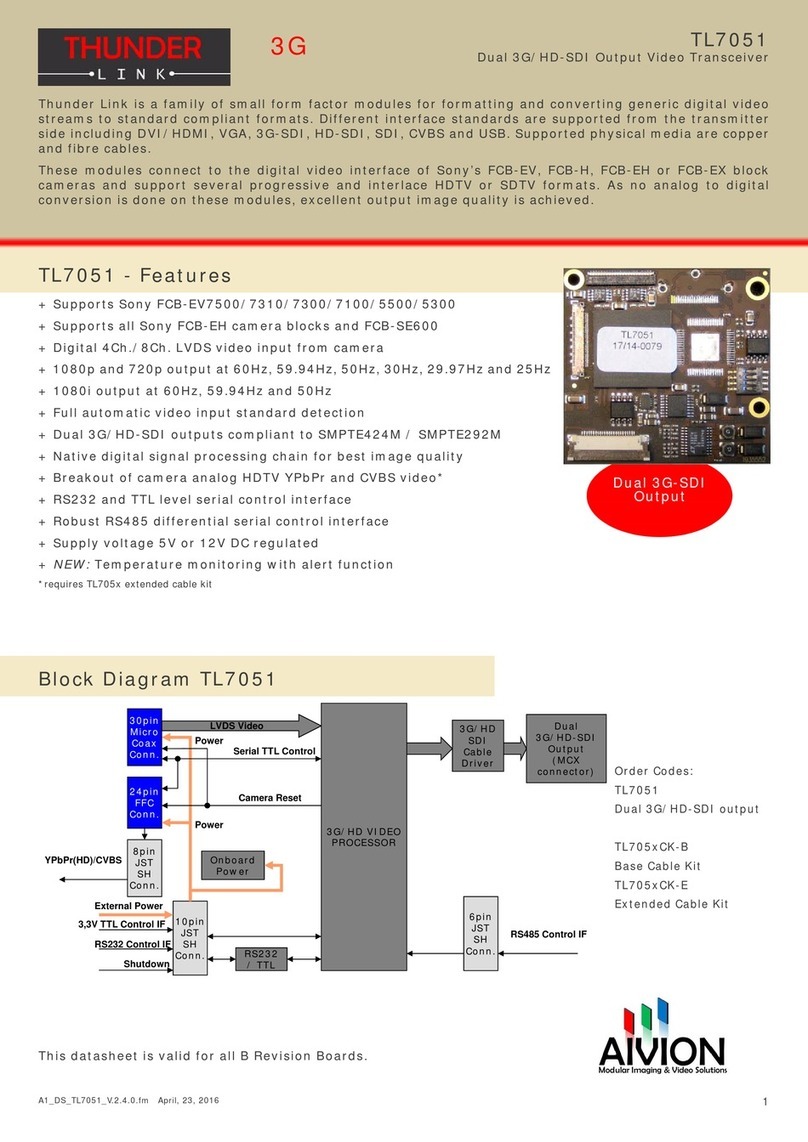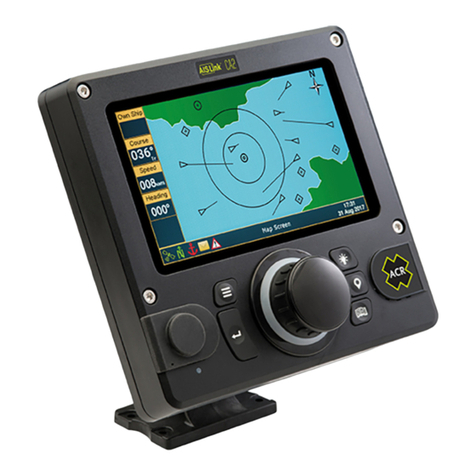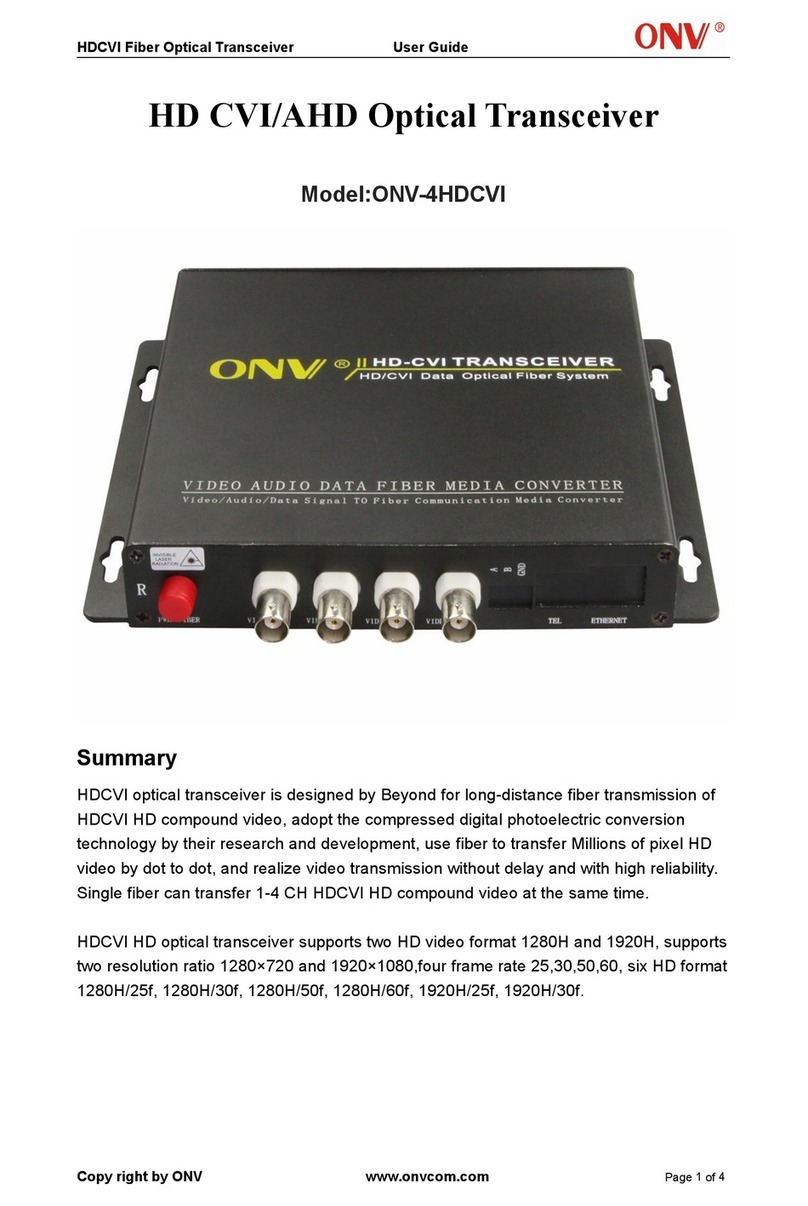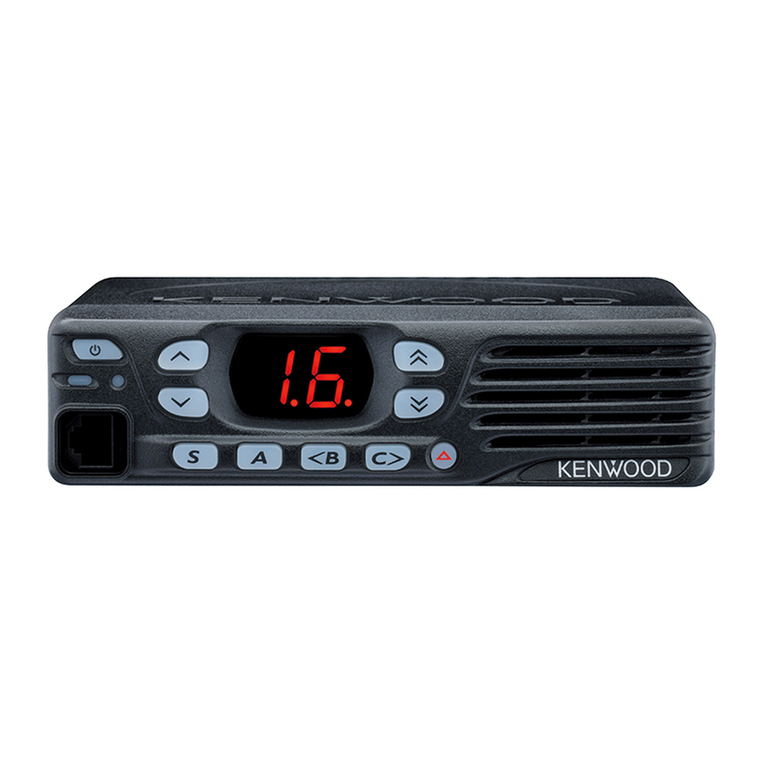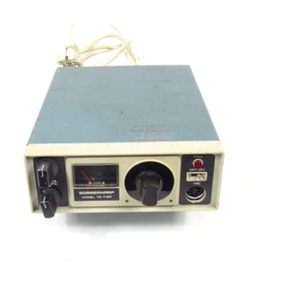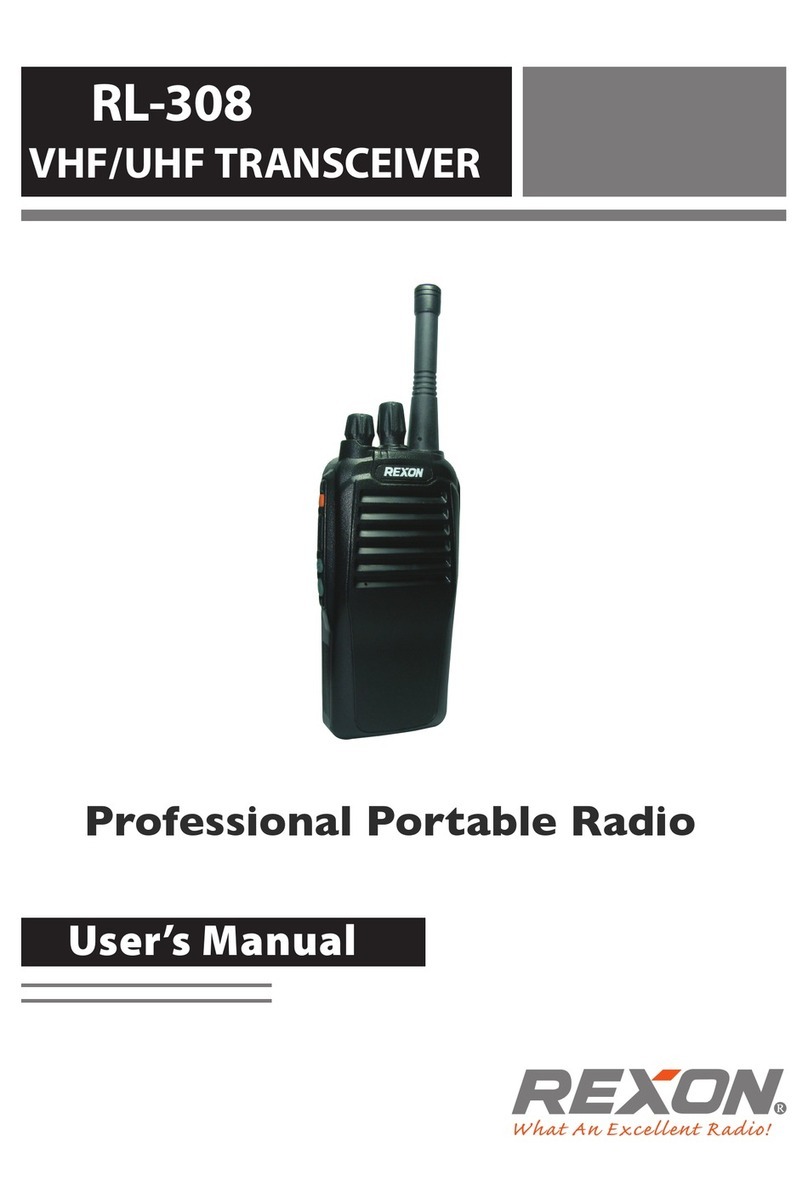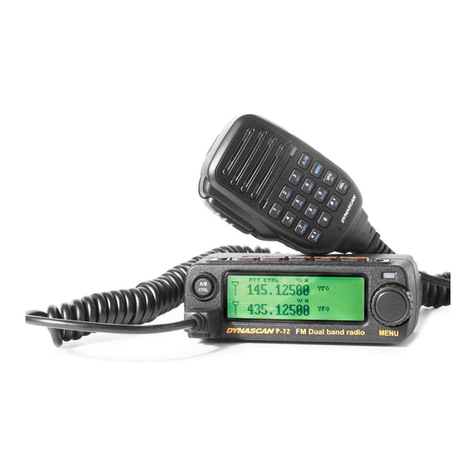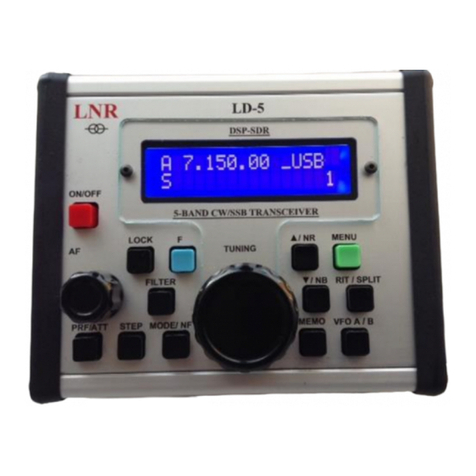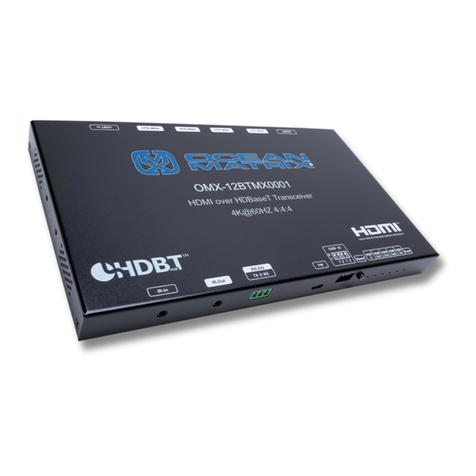Alinco DR-620T/E User manual

VHF/UHF FM TRANSCEIVER
DR-620T/E
Instruction Manual
Thank you for purchasing your new Alinco transceiver.
This instruction manual contains important safety and operating instructions. Please read this
manual carefully before using the product and keep it for future reference.
Printed in Japan
Copyright Alinco,Inc. 2002 PS00000
ALINCO,INC.
Head Office: Shin-Dai building 9th Floor
2-6, 1-Chome, Dojimahama, Kita-ku,
Osaka 530-0004, JAPAN
Phone:+81-6-4797-2136 Fax:+81-6-4797-2157
E-mail:[email protected]

NOTICE
This equipment has been tested and found to comply with the limits for a Class B digital device,
pursuant to part 15 of the FCC Rules.
These limits are designed to provide reasonable protection against harmful interference in a residential
installation. This equipment generates, uses, and can radiate radio frequency energy and, if not installed
and used in accordance with the instruction manual, may cause harmful interference to radio communi-
cations. However, there is no guarantee that interference will not occur in a particular installation. If this
equipment does cause harmful interference to radio or television reception, which can be determined by
turning the equipment off and on, the user is encouraged to try to correct the interference by one or
more of the following measures:
• Reorient or relocate the receiving antenna.
• Increase the separation between the equipment and receiver.
• Connect the equipment into an outlet on a circuit different from that to which the receiver is
connected.
• Consult the dealer or an experienced radio/TV technician for help.
Tested to Comply
With FCC Standards
FOR HOME OR OFFICE USE
Information in this document is subject to change without notice or obligation. All brand names and
trademarks are the property of their respective owners. Alinco cannot be liable for pictorial or typo-
graphical inaccuracies. Some parts, options and/or accessories are unavailable in certain areas. Changes
or modifications not expressly approved by the party responsible for compliance could void the user's
authority to operate the equipment.
Conformity Information
In case the unit you have purchased is marked with a CE symbol, a copy of relative conformity certifi-
cate or document can be reviewed at http://www.alinco.com/usa.html.
Copyright © 2002All rights reserved. No part of this document may be reproduced, copied, translated
or transcribed in any form or by any means without the prior written permission of Alinco. Inc., Osaka,
Japan. English Edition Printed in Japan.
Compliance Information Statement
VHF/UHF FM Transceiver DR-620T/E
This device complies with Part 15 of the FCC Rules. Operation is subject
to the following two conditions: (1) This device may not cause harmful
interference, and (2) this device must accept any interference received,
including interference that may cause undesired operation.
U.S. Representative: ATOC Amateur Distributing LLC
23 South High Street
Covington, OH 45318
Telephone: 937-473-2840

1
Contents
Before operating the transceiver .............3
Attention ................................................................ 3
Introduction ...............................................3
New and Innovative Features ...................4
Standard Accessories ..............................5
Initial Installation .......................................6
For a base station set up ....................................... 6
For a mobile station set up .................................... 7
Location .................................................... 7
Installing a Mobile Antenna ....................... 7
Installing the Transceiver .......................... 7
Front Panel ............................................................ 8
External power supply control function .................. 9
Power supply voltage display function................. 10
Part Names and Functions .....................11
Front Panel ...........................................................11
Rear Panel........................................................... 12
Display ................................................................. 13
Microphone EMS-53 (Standard) .......................... 14
Basic Operations.....................................15
Turning the unit on and off ................................... 15
Switching the MAIN band .................................... 15
Audio Volume level setting .................................. 15
Squelch level setting............................................ 15
Squelch level setting on the SUB side .... 15
VFO mode ........................................................... 16
Change frequency by the channel step .. 16
Change frequency by 1 MHz step........... 16
Setting the channel step ...................................... 17
Shift Direction and Offset frequency setting ........ 18
Memory Mode...................................................... 19
Recalling a memory channel................... 19
How to program memory ........................ 20
Memory channel deleting .................................... 21
Programmable data in the memory channel ...
21
Channel name (Alphanumeric) registration function.....
22
CALL mode .......................................................... 23
To recall a CALL channel..................................... 23
To receive signals ................................................ 23
Monitor function ................................................... 24
Reverse function.................................................. 24
To transmit ........................................................... 25
Switching the transmission power........... 25
Parameter Setting Mode .........................26
A list of the setting mode ..................................... 26
To use the setting mode ...................................... 27
Channel Step setting ........................................... 28
Scan Type ............................................................ 28
Beep Sound ......................................................... 28
Time-Out-Timer.................................................... 29
TOT Penalty......................................................... 29
Setting the TOT penalty time .................. 29
APO-Auto Power OFF ......................................... 30
Tone-Burst Frequency ......................................... 30
Clock shift ............................................................ 30
Bell....................................................................... 31
Busy-Channel-Lock-Out (BCLO) ......................... 31
Theft Alarm .......................................................... 31
Illumination color setting ...................................... 32
Dimmer ................................................................ 32
Call sign setting (In packet operation) ................. 32
Transmission speed setting (In packet operation) ........
33
Beacon interval setting (In geolocating communication)
33
Useful functions ......................................34
Reception band switching.................................... 34
V-V/U-U simultaneous reception ......................... 34
Single-band mode ............................................... 35
VFO Auto-program setting function ..................... 35
SCANNING FUNCTION ...................................... 36
•VFO Scan .............................................. 36
•Memory Scan ........................................ 37
•Skip-channel setting .............................. 37
•Program Scan........................................ 38
•Tone Scan.............................................. 38
•DCS scan .............................................. 39
KEY-LOCK FUNCTION ....................................... 39
TONE BURST...................................................... 39
Narrow-band mode .............................................. 40
AM receiver mode ............................................... 40

2
Contents
Selective Communication ...................... 41
Tone-squelch (CTCSS) and DCS ........................ 41
DET setting ............................................. 42
Digital voice communication (DR-620T only)..
43
Special Functions ................................... 44
THEFTALARM .................................................... 44
To connect, set and operate ................... 44
How the alarm operates.......................... 45
Setting alarm starting time ...................... 46
Cable Clone ......................................................... 47
Connection.............................................. 47
Setting on the Slave side ........................ 47
Setting on the Master side ...................... 48
Packet Communication........................................ 49
When using EJ-50U ................................ 49
Packet Mode Setting............................... 50
APRS ................................................................... 51
APRS Setting .......................................... 51
For operation........................................... 52
TNC Clone .............................................. 53
Remote Control Operation (EMS-570 only)......... 54
List of Remote Control Keys ................... 54
Entering a frequency directly .................. 55
Entry method depending on tuning step . 55
Maintenance / Reference ........................ 56
Reset ................................................................... 56
Factory Default Settings.......................... 56
Troubleshooting ................................................... 57
Optional accessories ........................................... 58
Transmitter Chart ................................................. 59
Specification ........................................................ 60

3
Before operating the transceiver
Attention
• Do not remove the case or touch the interior components.
Tampering can cause equipment trouble.
• Do not use or keep the transceiver where it is exposed to direct sunlight, dusty
places, or near sources of heat.
• Keep the transceiver away from TV's or other equip-
ment when it interferes with reception.
• When transmitting for long periods of time at high
power, the transceiver might overheat.
• Turn the power off immediately if the transceiver
emits smoke or strange odors. Ensure the transceiver
is safe, then bring it to the nearest Alinco service
center.
Introduction
Thank you very much for purchasing this excellentAlinco transceiver. Our products
are ranked among the finest in the world. This radio has been manufactured with
state of the art technology and it has been tested carefully at our factory. It is de-
signed to operate to your satisfaction for many years under normal use.
PLEASE READ THIS MANUAL COMPLETELY TO LEARNALL THE FUNC-
TIONS THE PRODUCT OFFERS. WE MADE EVERY ATTEMPT TO WRITE
THIS MANUAL TO BEAS COMPREHENSIVEAND EASY TO UNDERSTAND
AS POSSIBLE. IT IS IMPORTANT TO NOTE THAT SOME OF THE OPERA-
TIONS MAY BE EXPLAINED IN RELATION TO INFORMATION IN PREVI-
OUS CHAPTERS. BY READING JUST ONE PART OF THE MANUAL, YOU
RISK NOT UNDERSTANDING THE COMPLETE EXPLANATION OF THE
FUNCTION.

4
New and Innovative Features
Your new radio features some of the most advanced functions and reliable engineering
available anywhere. The ALINCO design philosophy is focused on developing innova-
tive usable features, including the following:
• A large, color-selectable display panel
Very clear display of frequency, memory name etc. ensure convenient operation.
• Excellent frequency stability
By using a temperature compensated crystal oscillator (TCXO), deviation less than
+/- 2.5ppm is realized.
• V-V/U-U function
Simultaneous reception of 2 signals within a same frequency band is possible (Exclud-
ing FM broadcasting band).
• High-quality materials are used throughout the product and a huge heat sink around
the chassis ensures stable and durable operation.
• AM Air-band reception capability (T models only)
• 200 fully programmable memory channels with alphanumeric memory channel labels
• CTCSS, DCS and 5 different Tone-Bursts are standard for selective calling and re-
peater access worldwide.
• Applicable for APRS®/Packet communication (With the optional EJ-50U installed)*
• Theft Alarm feature
• Auto-Programming VFO for easier repeater access
• Cable-Clone function
• Power supply voltage display function
• Narrow-FM mode
• Microphone remote control function (EMS-57 microphone may be on option depend-
ing the version.)
• Front-Control unit separation
*APRS®isatrademarkofMr.BobBruninga,WB4APR.

5
Standard Accessories
Carefully unpack to make sure the following items are found in the package in addition to this manual:
• Transceiver
• Mobile mounting bracket. (FM0078Z)
• DC power cable with fuse holder (UA0038)
•ACC cable (UX1290A)
• Theft Alarm stickers 2pcs. (PR0454)
• Instruction manual (this manual)
•
Warranty certificate(Tversiononly) (PH0009A)
• EJ-50U manual & disc (with TNC version only)
• Hardware kit for bracket
• Microphone EMS-53 or EMS-57 (with
DTMF keypad)
The standard accessories may vary slightly depending on the version you have purchased. Please contact
your local authorizedAlinco dealer should you have any questions. ALINCO and authorized dealers are
not responsible for any typographical errors there may be in this manual. Standard accessories may change
without notice.
Warranty Policy:
Please refer to any enclosed warranty information or contact your authorized Alinco dealer / dis-
tributor for the warranty policy.

6
Initial Installation
Connect the microphone to the front panel of the transceiver.
Connect antenna port to a 50 ohm antenna that covers the 2 m/70 cm bands, using good quality
50 ohm coaxial cable.
Microphon
e
connector
Antenna
External speaker
(if used)
Microphone
rear panel
For a base station set up
The Transceiver requires a 12-13.8VDC negative grounded power source.
Use a regulated power supply capable of providing continuous current of 12A or more.
Power supplies that do not meet those specifications may cause malfunction and/or damage to the
radio and will void the warranty. Alinco offers excellent communication-grade power supplies as
optional accessories. Please contact your local authorized Alinco dealer.
DC
power supply
DC power cable
Black lead
Red lead

7
Initial Installation
For a mobile station set up
Location
The transceiver may be installed in any position in your car, where the controls and microphone are
easily accessible and it does not interfere with the safe operation of the vehicle or the performance
of the set. If your vehicle is equipped with air bags, be certain your radio will not interfere with
their deployment. If you are uncertain about where to mount the unit, contact your vehicle's manu-
facturer. Please refer the next page for front control unit setting.
Installing a Mobile Antenna
Use a 50 ohm coaxial cable to connect the antenna. Mobile antennas require an appropriate mount-
ing base for proper installation and operation. For more information, see the documentation for
your antenna.
Installing the Transceiver
See the figure on the below.
b
a
a
b
IMPORTANT: After installing your antenna, ensure that you have the best possible SWR reading.
High RF environments can cause severe damage to your unit. Ensure that you are not
in a high RF environment when operating the transceiver.

8
Initial Installation
NOTE: By using the optional separation kit EDS-9, you can use the front panel and the main unit in
a separate position. The instruction is provided in the EDS-9.
Front Panel
The main unit can be set with either side facing up.
Fix the front panel as you prefer.
1. Slide the front panel while keeping the knob pressed.
2. Turn the front panel
3. Match the catch in the main unit with the slot in the front panel and fit the front
panel into the main unit.
4. Slide the front panel.
Main unit
Front panel
Knob
Slot
Catch

9
Initial Installation
External power supply control function
1. Be sure the vehicle has a negative-ground, 12VDC electric system before installa-
tion. Connect the provided DC cable with fuse-holder directly to the battery (red
cable to the positive terminal) to minimize any possible ignition noise. Be sure the
vehicle has a large capacity battery as the use of a transceiver may overload the
electric system of the vehicle.
2. In addition, if the optional ignition-key ON/OFF feature is desired, use the provided
ACC cable. Remove the cover by unscrewing 4 screws. Connect the ACC cable to
the ACC power jack (CN11) on the rear side of the unit inside, trim the outgoing
cable as shown above, select the ACC switch (SW11) to ACC position and reas-
semble the cover.
3. Be sure to cut the electric power supply off (by disconnecting the battery cables of
the vehicle) and the ignition key is at OFF position for you and your car's safety.
Connect another end of the ACC cable to the ACC terminal or ACC switch on the
vehicle. Make sure all above sequence has been done properly. Set the vehicle's
electric system back normal.
4. If this option is selected, the unit can be turned on/off either manually or automati-
cally in accordance with the ignition key position.
A: When the ignition key is turned to ACC or ON (start) position with the unit left
turned ON, the unit will turn on automatically and turns OFF when the ignition
key is turned to the OFF position.
B: To manually ON/OFF the power, leave the ignition key to ACC position and use
PWR switch on the unit. If the ignition key is at OFF position the unit won't turn
on. The power consumption, regardless of the ignition key position, of this fea-
ture is about 5mA. For operation without this option, use the PWR switch to turn
the unit on/off always.
Red: For connection with the ACC power supply
Black:For connection with the grounding wire
Red CN11
SW11
ON
ACC
ACC external power supply control function is on
Black
In wiring, ensure
the tube comes
right in the slot
WARNING: The connection of cables may involve certain knowledge about the ve-
hicle the unit will be installed. Consult with your car-dealer or service sta-
tion for more information if necessary as we are not responsible of any
damage this installation might cause to your vehicle.

10
Initial Installation
Power supply voltage display function
After connecting the transceiver to the power supply, the supply voltage can be confirmed by press-
ing the SQL key together with the FUNC key. The supply voltage to the transceiver is then seen on
the display.
The transceiver will return to its normal operation when the power is switched OFF.
The display immediately changes as the voltage supply changes.
It also displays voltage during transmission.
(Example) In case of 13.6V
IMPORTANT: The range of the displayed voltage is only from 7 - 16VDC. Because the displayed
value is estimated, please use a voltmeter when a more precise reading is desired.

11
Part Names and Functions
Front Panel
BAND
CALL MHz
VV/UU
V/M
PWR
MAIN
VOL
MW
MAIN
TX/RX
SUB
VOL
SUB
RX
RX BAND SHIFT LOCK
PACKET DIGITAL
TS/DCS
H/L SQL FUNC
SET
VHF/UHF
VHF/UHF
TWIN B
TWIN B
AND FM
AND FM
TRANSCEVER
TRANSCEVER
DR-620
DR-620
16 32
8 9
10 14131211
7
5
15
4
•Primary Functions
No.
Key Function
1 PWR key Power turns ON/OFF whenever switch is pressed.
2
Main VOL knob
Adjusts the volume level on the MAIN band.
3
Sub VOL knob
Adjusts the volume level on the SUB band.
4 Main TX/RX During transmission on the MAIN, illuminates in Red,
indicator and during reception illuminates in Green.
5 Sub RX lamp During reception on the SUB, illuminates in Green.
6 V/M/MW Switches between VFO mode and memory mode.
7 Dial
Changes the frequency, memory channel and various settings.
8 BAND/VVUU Switches the MAIN band to VHF or UHF.
9
CALL/RX BAND
Switches to CALL Mode.
10 MHZ/SHIFT In VFO mode, changes frequency in 1 MHz steps.
11
TSDCS/LOCK
Sets the tone squelch and DCS setting.
12 HL/ PACKET Switches HI/MID/LOW of transmission power.
13 SQL/DIGITAL Sets the squelch level.
14 FUNC/SET Sets functions.
15
Mic. Connector
Connects the provided microphone.
•
Functions which can be activated while [F] appears, after pressing the FUNC Key
No.
Key Function
6 V/M/MW Write in to memory channel.
8
BAND/VVUU
Switches to VV/UU mode.
9
CALL/RXBAND
Switches reception bands.
10 MHZ/SHIFT Sets the shift direction and the offset frequency.
11
TSDCS/LOCK
Sets the key lock function.
12 HL/PACKET Accesses the packet communication mode or the
geolocating communication mode.
13
SQL/DIGITAL
Accesses the digital voice communication mode.
* [F] illuminates when the FUNC key is pressed.

12
Part Names and Functions
Rear Panel
4 3 5 2
1
No.
Key Function
1
External Speaker Terminal
Terminal for optional external speaker.
(Also used for the clone function.)
2 Power cable Connects to the 13.8VDC power supply.
3 Air-cooling fan
Cools the unit during transmission. (PTT activation)
4 Antenna Connector Connect an optional antenna for 50 ohm
impedance. (PL-259 or compatible)
5
D-SUB Connector (Optional)
Connects to a personal computer for packet use.
•
Functions that can be activated while pressing the FUNC Key
No.
Key Function
1 PWR Reset to factory default settings.
5 V/M/MW Erase the memory.
8 BAND/VVUU Switches to the single band mode.
9
CALL/RXBAND
Accesses the clone function mode.
10 MHZ/SHIFT Switches to wide/narrow mode reception.
11
TSDCS/LOCK
Switches to the AM reception mode.
12 HL/PACKET Sets the channel name function.
13 SQL/D Accesses the power supply voltage indication mode.
• Functions that require continuous pressing to be activated.
No.
Key Function
13 SQL/DIGITAL When pressed for 1 second, the monitor function is on.
(When the shift is set, the reverse function is on.)
14 FUNC/SET When pressed for 2 seconds, accesses the set mode.

13
Part Names of Functions
Display
DCS
SUB
TNC
R
AM
SQL
BUSY BUSY1 3 5 7 9
MiLo
Nar
2 3 4 5 6 7 8 9
10 11 12 13 14 15
1
23 22 21 20 19 18
16
17
24
25
No.
Key Function
1Appears when FUNC Key is pressed.
2AM Appears during AM reception.
3Mi Appears when transmission power is set to MID.
4Lo Appears when transmission power is set to LOW.
5 Nar Appears when in narrow band reception mode.
6 +/- Appears when setting the shift.
7Appears when setting the tone squelch.
8 DCS Appears when setting the DCS.
9 SUB Appears when SUB band is on the MAIN side.*
10 Appears when setting the key lock.
11 * Appears when setting the theft alarm function.
12 TNC
Appears when in packet mode (Optional EJ-50U required).
13
Appears when SUB band is in the memory mode or call mode.
14 R Appears when the reverse function is activated.
15 Appears when in the digital voice communication mode.**
16 Appears when setting the bell (pager) function.
17 Indicates the frequency or memory name on the SUB side
18 S Meter Indicates the relative signal strength level of transmission/
reception on the SUB side.
19 Appears when a signal is being received on the SUB side.
20 Indicates the frequency or memory name on the MAIN side.
21 S Meter Indicates the relative signal strength level of transmission/
reception on the MAIN side.
22
.Decimal point
Appears when changing the DCS decode settings.
Disappears when setting the skip.
23 Appears when a signal is being received on the MAIN side.
24 SQL Appears when setting the squelch level.
25 Indicates memory numbers in the memory mode.
*SUB band is the band exclusive for reception when in V-V/U-U.
** T version only. Optional EJ-47U required.

14
Part Names and Functions
Microphone EMS-53 (Standard)*
Mic. Connector Diagram (While looking in the front view of the connector)
17
26
345
8
PTT
MIC MIC GND
REMOT
E
DC 5V
UP
GND
DOWN
21
3
5
4
No.
Key Function
1UP
Increase the frequency, memory channel number, or setting value.
2 DOWN
Decrease the frequency, memory channel number, or setting value.
3 PTT Press the PTT(Push-To-Talk)key to transmit.
4 DTMF DTMF tone keys
DTMF / REMOTE
5
Switch
6 Lock Switch Locks out the UP and DOWN keys.
7 MIC Speak here during transmission.
Set to DTMF when you don’t want to operate remote con-
trol functions. So that DTMF keys do not function except
during transmit to send DTMF codes manually.
* If the version you have purchased contained EMS-57 Multi-function microphone, please
also refer page 54.

15
Basic Operations
Turning the unit on and off
By pressing the PWR key the power is turned on. By pressing
the PWR key again, the power is turned off. Refer page 9 for
external power supply control.
Switching the MAIN band
Repeating to press the BAND key will switch the MAIN band
between VHF band and UHF band.
The MAIN band allows transmission and reception.The SUB
band only allows reception. The MAIN band and the SUB
band can receive simultaneously.
Audio Volume level setting
The volume of the MAIN band is adjusted by the VOL knob
on the MAIN side, and the volume of the SUB band by the
VOL knob on the SUB side.
Rotate the VOL knob clockwise to increase the audio level,
counterclockwise to decrease.
SQL
Squelch level
MHz
PWR
SUB
VOL
SUB
RX
D
SHIFT LOCK
PACKET DIGITAL
TS/DCS
H/L SQL FUNC
SET
F
/UHF
VHF/UHF
TWIN B
TWIN B
AND FM
AND FM
TRANSCEVER
DR-620
PWR key
MAIN side VOL knob
SUB side VOL knob
low high
BAND
CALL MHz
VV/UU
V/M
PWR
MAIN
VOL
MW
MAIN
TX/RX
SUB
VOL
SUB
RX
RX BAND SHIFT
ET DIGITAL
SQL FUNC
SET
RANSCEVER
RANSCEVER
DR-620
VHF/U
VHF/U
Volume
low high
Volume
BAND
CALL MHz
VV/UU
V/M
MAIN
VOL
MW
MAIN
TX/RX
RX BAND SHIFT LOCK
PAC K
TS/DCS
H/L
VHF/UHFVHF/UHF TWIN BTWIN BAND FMAND FM TRANTRANSCEVER
DR-620
BAND Key
Squelch level setting on the SUB side
To set the squelch level on the SUB side, press the BAND key while [SQL] appears.
1. Press SQL Key.
[SQL] icon appears on the display and the
squelch level will be shown on it.
2. By rotating the main dial or by using the UP/
DOWN keys on the microphone, adjust the
squelch level to the desired level.
The new squelch level will be stored if the power
is turned off.
3. When completing the setting, press PTT or any
key on the front panel other than the Band key.
Then the display will return to the original sta-
tus; or if there are no operations for 5 seconds,
the unit will automatically complete the setting
and the display will return to the original status.
NOTE: • 21 levels, between (00) and (20), are available for the squelch level.
(Higher level settings will make the squelch more difficult to open.)
• The default level is 02.
Squelch level setting
Adjust threshold level of the squelch. A squelch eliminates the background noise when a signal is
not received. To set squelch level on the MAIN band side,
IMPORTANT: On the SUB side, no setting other than the fre-
quency and S meter is indicated.

16
Basic Operations
VFO mode
VFO tuning is set as a default mode at the factory. VFO (vari-
able frequency oscillator) allows you to change the frequency
in accordance with the selected channel step as you rotate the
main dial or by using the UP/DOWN keys on the microphone.
VFO mode is also used to program the data to be stored in the
memory channels or to change the parameter settings of the
transceiver.
1. Identify the current mode by checking the dis-
play. If “M” or “C” icon is NOT displayed on
it, the unit is already in the VFO mode.
If memories have not been programmed, the unit
will not be switched to the memory mode.
2. Otherwise press “V/M” keys until those icons
are gone.
Change frequency by the channel step
Rotate the main dial clockwise to increase the frequency, coun-
terclockwise to decrease. The UP/DOWN keys on the micro-
phone act in the same way.
Change frequency by 1 MHz step
This will enable a quick change of frequency in 1 MHz steps:
1. Press MHz key. The digits after 100 kHz will
disappear from the display.
2. Follow the same sequence as above to change
the value.
VFO mode
Dial
Frequency
increase
Frequency
decrease
BAND
CALL MHz
VV/UU
V/M
MAIN
VOL
MW
MAIN
TX/RX
RX BAND SHIFT LOCK
PAC
K
TS/DCS
H/
L
VHF/UHF TWIN BAND FM TRA
NVHF/UHF TWIN BAND FM TRANSCEVER
DR-620
Memory mode

17
Basic Operations
Setting the channel step
1. When the unit is in VFO mode, enter into the
SET mode and select the channel step setting
display. (Refer to page 32 and 33 for SET
mode).
2. The current channel step will be displayed.
3. You can change the channel step as below by
rotating the dial.
4. Pressing any key other than FUNC key or SQL
key on the unit will complete the setting and
the display will return to the original status.
Channel step setting display (default)
STEP 5
(5 kHz)
STEP 50
(50 kHz)
STEP 100
(100 kHz) STEP 30
(30 kHz) STEP 25
(25 kHz) STEP 20
(20 kHz)
STEP 8.33
(8.33 kHz) STEP 10
(10 kHz) STEP 12.5
(12.5 kHz) STEP 15
(15 kHz)
IMPORTANT: By changing the channel step frequency, settings below 10kHz may be auto-
matically corrected.

18
Basic Operations
Shift Direction and Offset frequency setting
Conventional repeaters are operated in the DUPLEX mode, which receives an incoming
signal on one frequency and re-transmits on another. The difference between these two fre-
quencies is called the offset frequency. The offset is variable between 0 to 99.995MHz on
this unit.
- 0.600 + 0.600
Shift release (off)
At –600kHz
1. After pressing the FUNC key, by pressing MHz
key while [F] appears on the display, the dis-
play will show the current status of offset fre-
quency and shift direction. By repeating to
press MHz key, shift direction will be changed
as right.
2. By rotating the dial (pressing UP/DOWN key)
while shift frequency is displayed, one click will
change the frequency by one channel step.
3. After pressing the FUNC key, rotating the dial
will change the frequency by 1MHz depend-
ing on which direction the dial is rotated (how
UP/DOWN key is pressed).
4. Pressing PTT key or V/M key will complete
the setting and the display will return to the
original status.
Other manuals for DR-620T/E
1
Table of contents
Other Alinco Transceiver manuals

Alinco
Alinco DJ-160T User manual

Alinco
Alinco DR-135TMkIII User manual
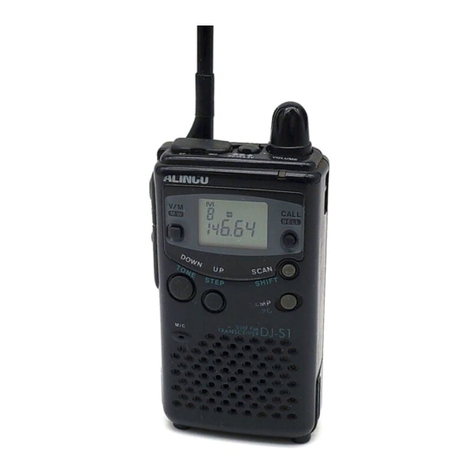
Alinco
Alinco DJ-S41T User manual

Alinco
Alinco DR-610T User manual
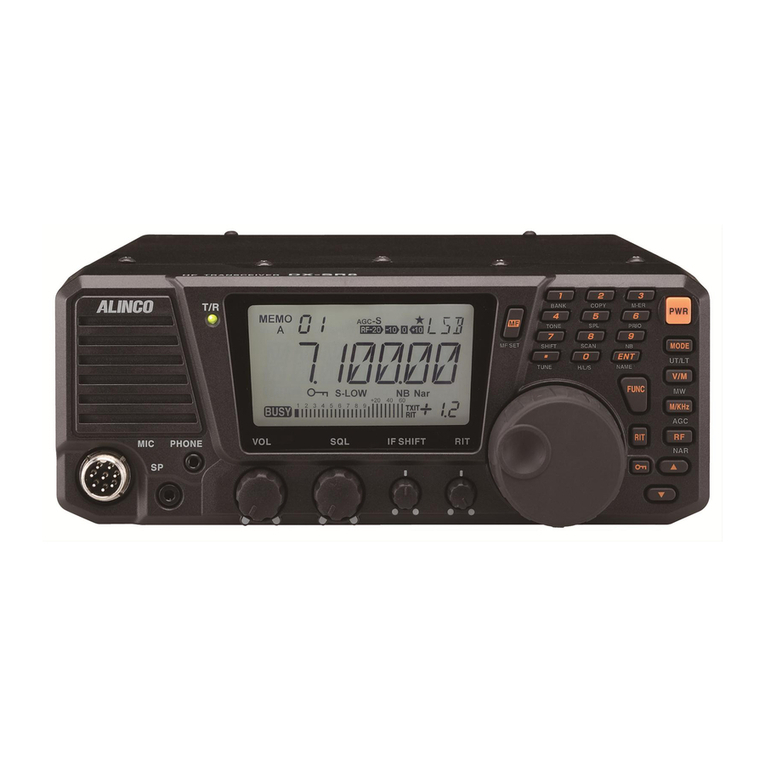
Alinco
Alinco DX-SR8 User manual

Alinco
Alinco DR-638H User manual
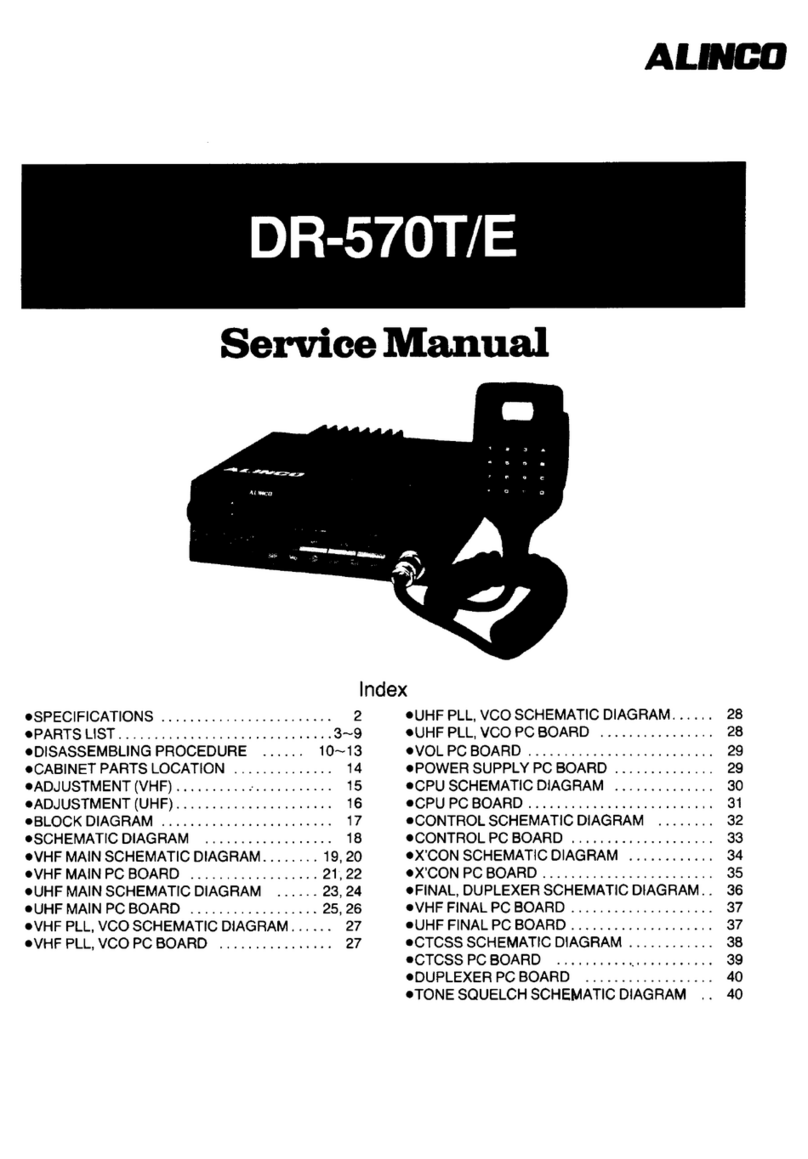
Alinco
Alinco DR-570T/E User manual
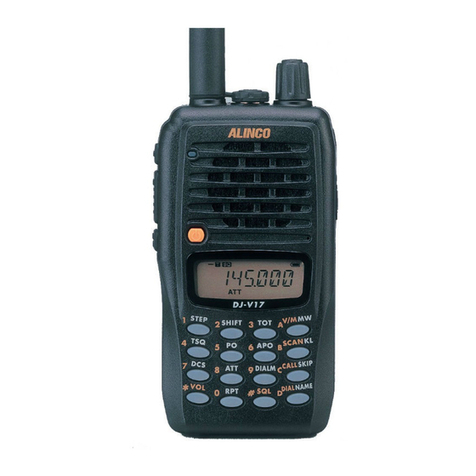
Alinco
Alinco DJ-V17TFH User manual
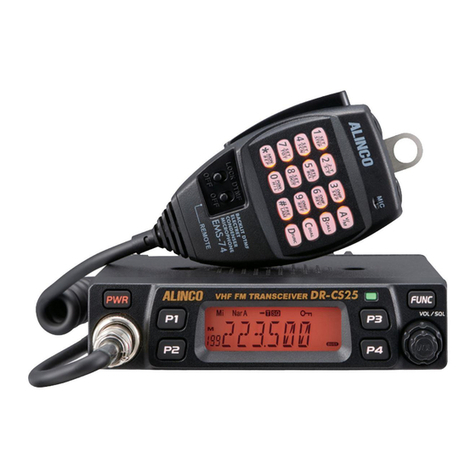
Alinco
Alinco DR-CS25 User manual
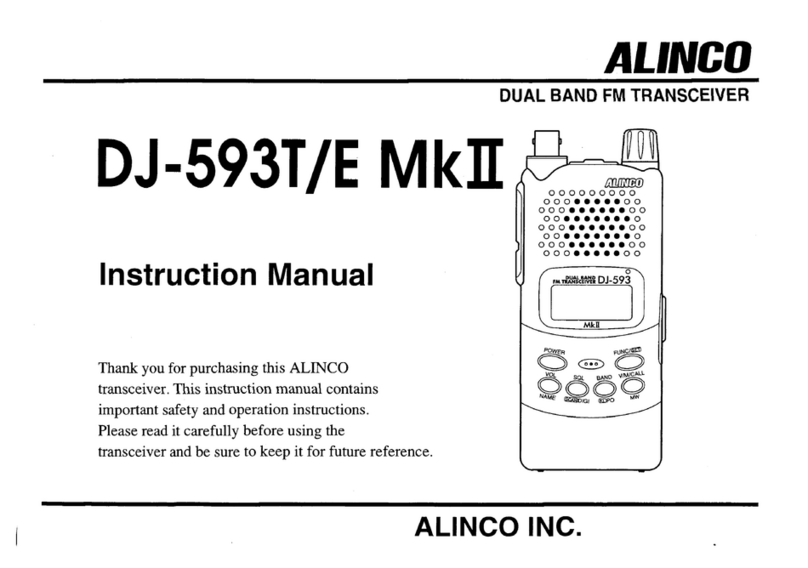
Alinco
Alinco DJ-593E MK II User manual

Alinco
Alinco DJ-S446 User manual

Alinco
Alinco DJ-200T User manual

Alinco
Alinco DJ-195R User manual
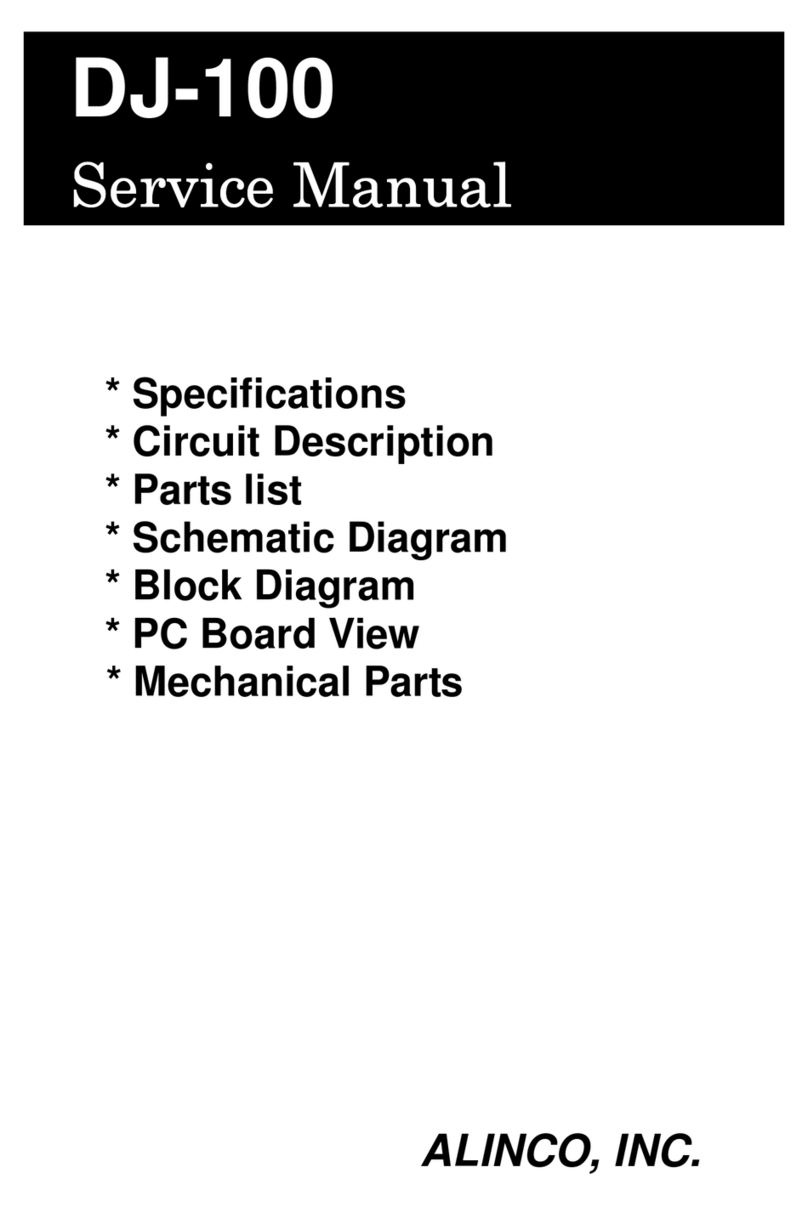
Alinco
Alinco DJ-100 User manual

Alinco
Alinco DR-M06T User manual
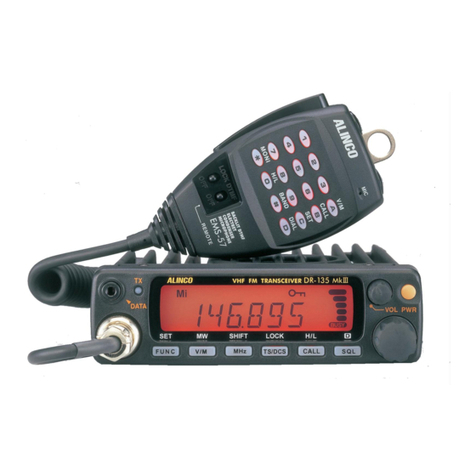
Alinco
Alinco DR-135T MkII User manual
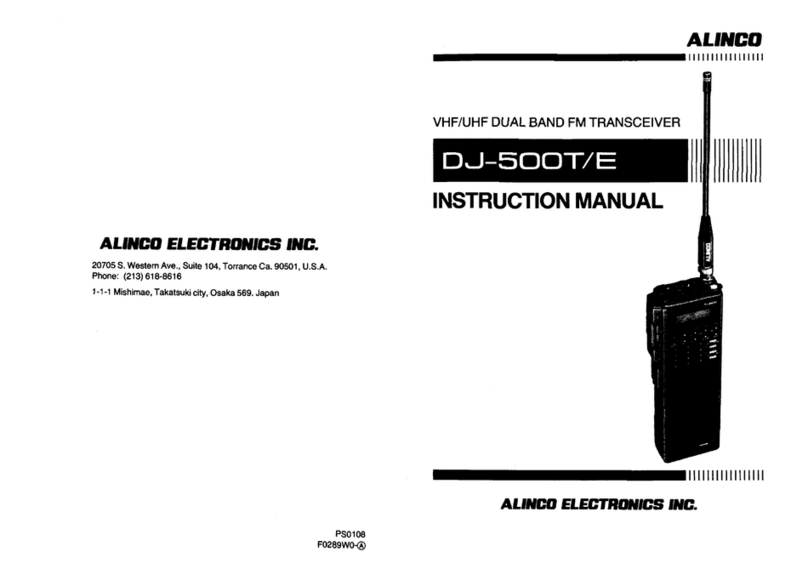
Alinco
Alinco DJ-500T User manual
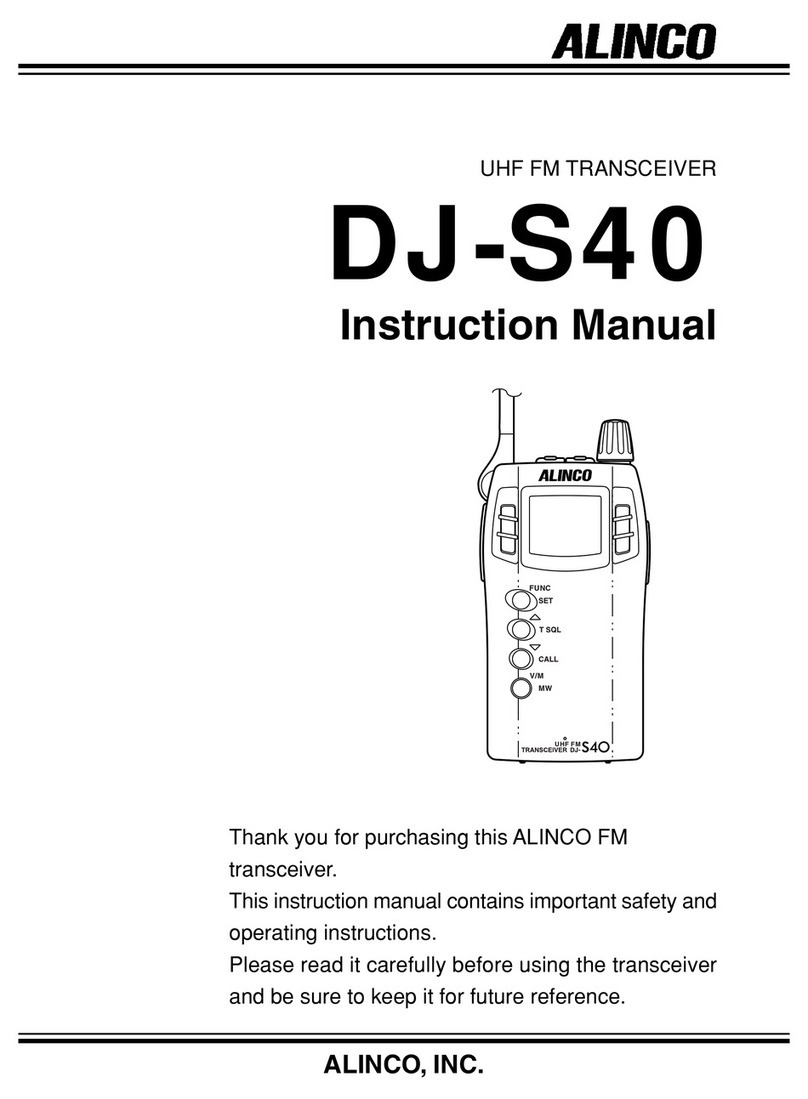
Alinco
Alinco DJ-S40 User manual

Alinco
Alinco DJ-493 User manual
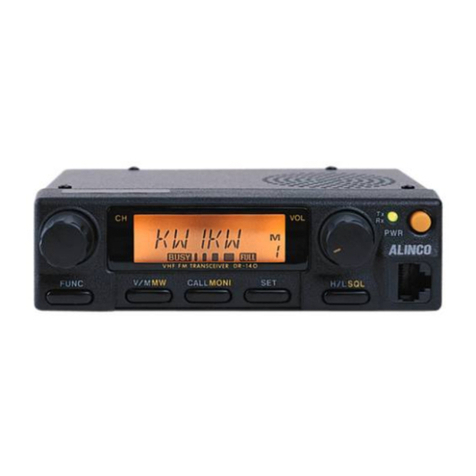
Alinco
Alinco DR-140T User manual

